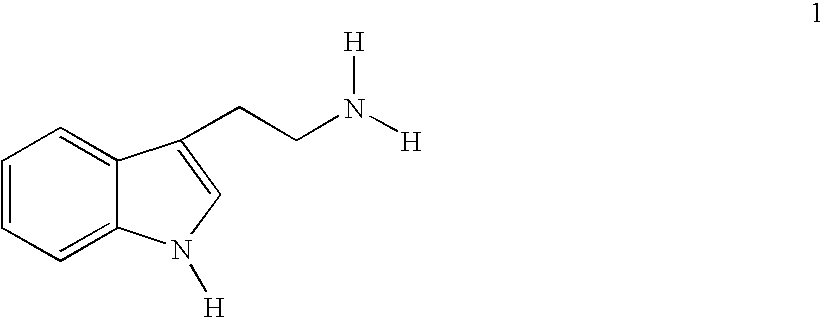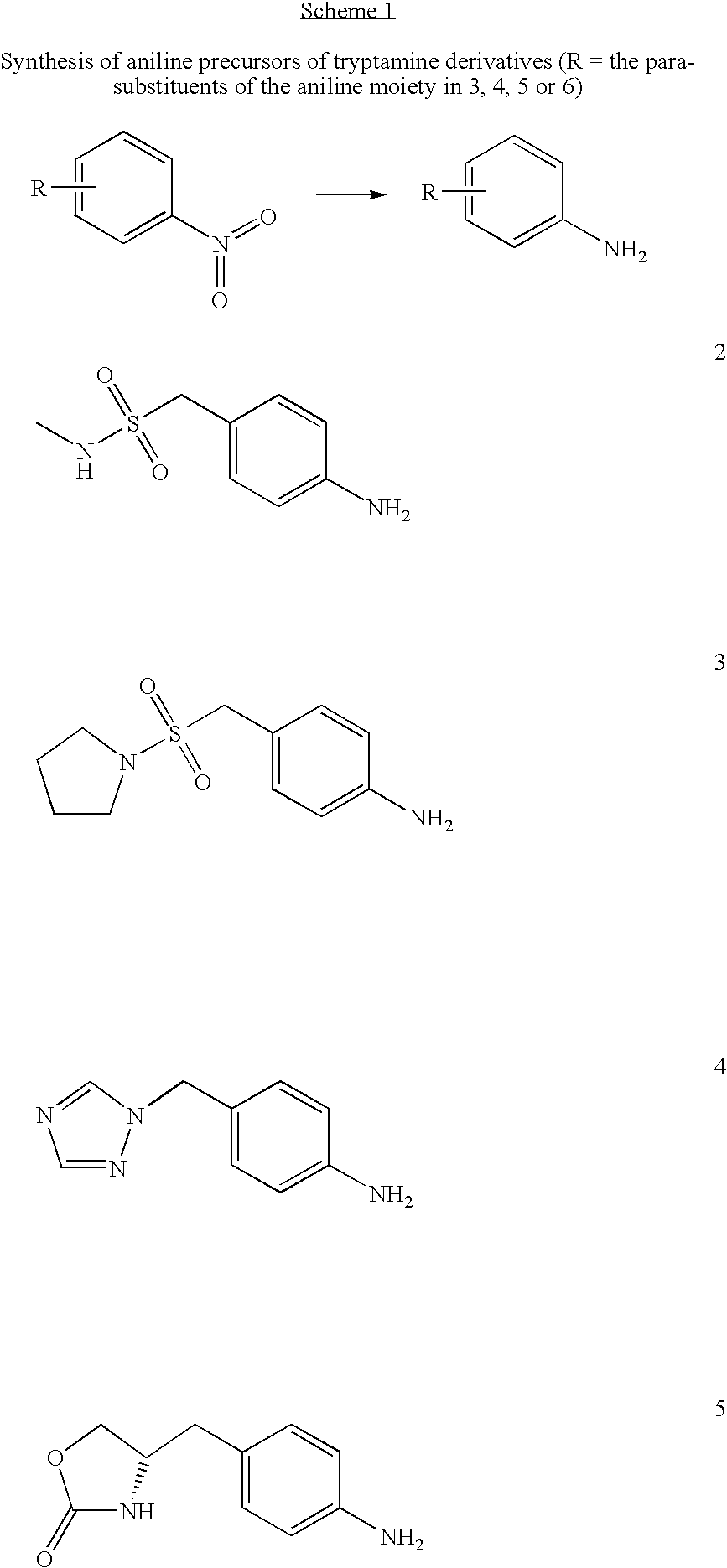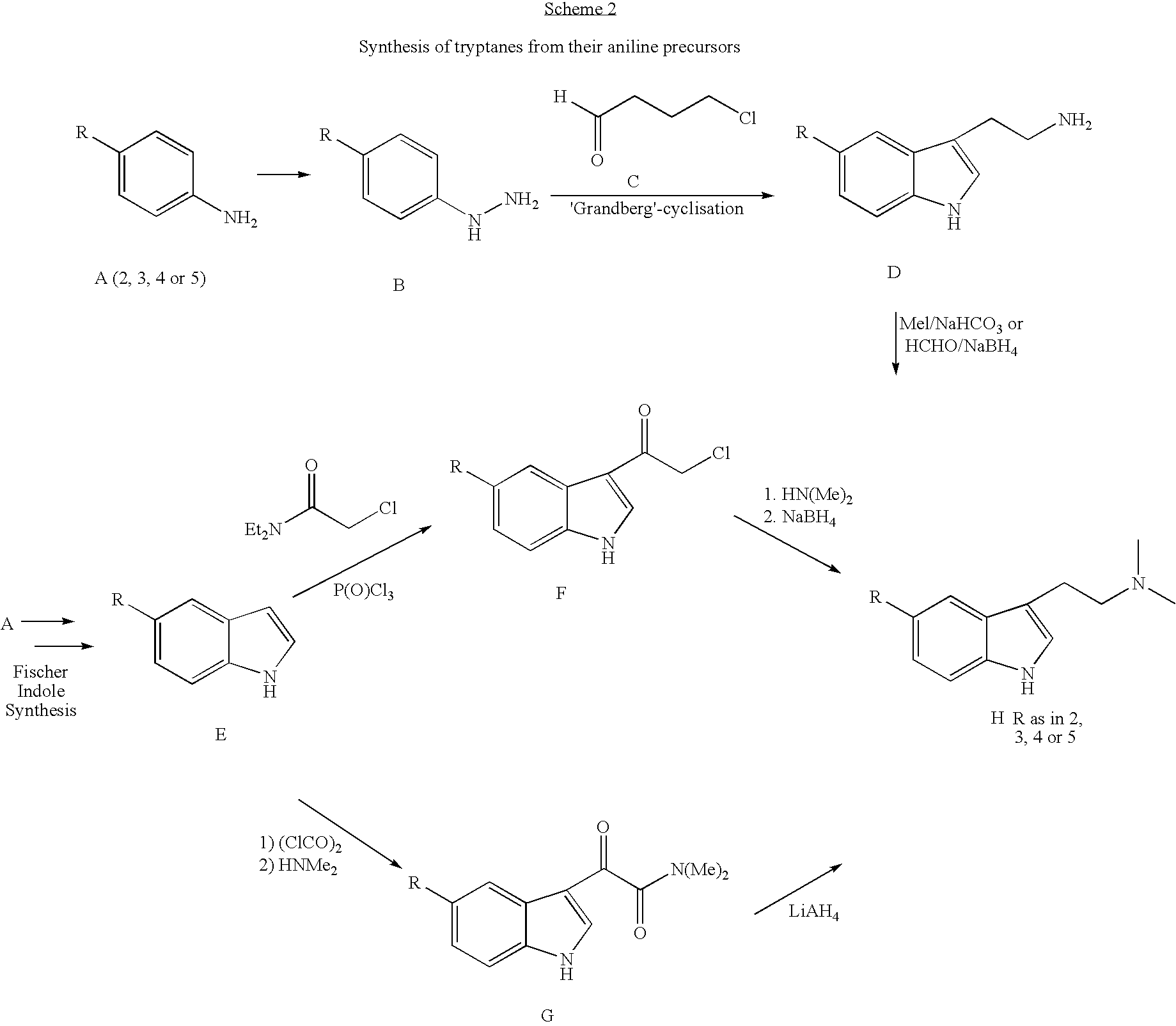Synthesis of amines and intermediates for the synthesis thereof
a technology applied in the field of synthesis of amines and intermediates for the synthesis thereof, can solve the problems of low yield of indole, and inability to reductively dimethylate the primarily formed tryptamine in an alternative way
- Summary
- Abstract
- Description
- Claims
- Application Information
AI Technical Summary
Benefits of technology
Problems solved by technology
Method used
Image
Examples
example 1
Preparation of 2-(5-Bromo-3-hydroxy-2-oxo-2,3-dihydro-1H-indol-3-yl)-N,N-dimethyl-acetamide
[0304]
[0305]A 2 L flask fitted with an inner thermometer, mechanical stirrer, and reflux condenser is charged with 5-bromo-isatin (100 g, 0.442 mol), malonic acid (55.2 g, 053 mol), pyridine (100.6 g, 1.274 mol), dimethyl formamide (80 g), and ethyl acetate (100 g). When the temperature of the mixture reaches 60° C., the bromo isatin starts to dissolve, and a deep red mixture forms. Carbon dioxide starts to evolve, and after about 45 minutes the precipitation of the intermediate pyridinium (5-bromo-3-hydroxy-2-oxo-2,3-dihydro-1H-indol-3-ylacetate starts. The reaction mixture is kept at 80° C. for another 3 hours. Then triethyl amine (49.2 g, 0.486 mol) iss added, and the pyridinium salt dissolves to give a deep brown solution. This solution is allowed to cool to 50° C., and then a solution of dimethyl carbamoyl chloride (48 g, 0.442 mol, CAUTION: carcinogen) in 40 g of ethyl acetate is added d...
example 2
Preparation of 2-(5-Bromo-1H-indol-3-yl)-N,N-dimethyl-acetamide
[0306]
[0307]A 1 L flask fitted with an inner thermometer, mechanical stirrer and dropping funnel is charged with 34.8 g of 2-(5-bromo-3-hydroxy-2-oxo-2,3-dihydro-1.H.-indol-3-yl)-N,N.-dimethyl-acetamide (0.111 mol) and 250 mL of dimethoxy ethane (DME). The obtained suspension is cooled with an ice bath, and then BF3-etherate (28.3 g, 0.2 mol) is added while the inner temperature is maintained at 20° C. This leads to the formation of a solution after a few minutes. The temperature is kept at 20° C., and 12.0 g of 95% borane dimethylsulfide complex (0.15 mol) is added dropwise during 10 minutes. The cooling bath is then removed, and the temperature of the mixture rises slowly, while a gas is formed. When the temperature reaches 48° C., the product starts to precipitate whilst the temperature continues to rise until it reaches 58° C. After about 10 minutes the temperature starts to fall to ambient temperature. After 75 minu...
example 3
Preparation of [2-(5-Bromo-1H-indol-3-yl)-ethyl]-dimethyl-amine
[0308]
[0309]A 1 L flask is charged with 2-(5-bromo-3-hydroxy-2-oxo-2,3-dihydro-1H-indol-3-yl)-N,N-dimethyl-acetamide (Example 1) (31.2 g, 0.1 mol), sodium borohydride (11.8 g 96%, 0.3 mol), and 250 mL of dimethoxyethanol (DME). The mixture is cooled to −15° C., and to the stirred suspension, BF3-etherate (56.6 g, 0.4 mol) is added dropwise. The temperature is maintained between −15 and −10° C. during the exothermic addition. The mixture is then allowed to warm slowly to ambient temperature (25-27° C.), and left stirring over night. The mixture is cooled with an ice bath and quenched by the addition of 4N NaOH (200 mL). The formed viscous emulsion is heated to 80° C. for 30 minutes, then diazabicyclo[2.2.2]cyclooctane (DABCO) (12.7 g 97%, 0.11 mol) is added, and then the mixture is heated for two additional hours under reflux. After cooling to ambient temperature, the aqueous layer is removed and the organic layer is extr...
PUM
| Property | Measurement | Unit |
|---|---|---|
| temperature | aaaaa | aaaaa |
| temperature | aaaaa | aaaaa |
| temperature | aaaaa | aaaaa |
Abstract
Description
Claims
Application Information
 Login to View More
Login to View More - R&D
- Intellectual Property
- Life Sciences
- Materials
- Tech Scout
- Unparalleled Data Quality
- Higher Quality Content
- 60% Fewer Hallucinations
Browse by: Latest US Patents, China's latest patents, Technical Efficacy Thesaurus, Application Domain, Technology Topic, Popular Technical Reports.
© 2025 PatSnap. All rights reserved.Legal|Privacy policy|Modern Slavery Act Transparency Statement|Sitemap|About US| Contact US: help@patsnap.com



